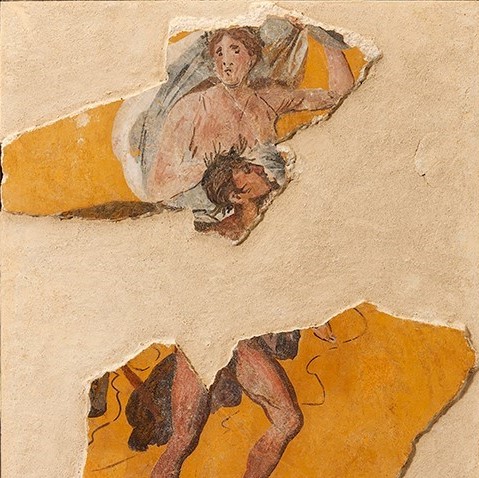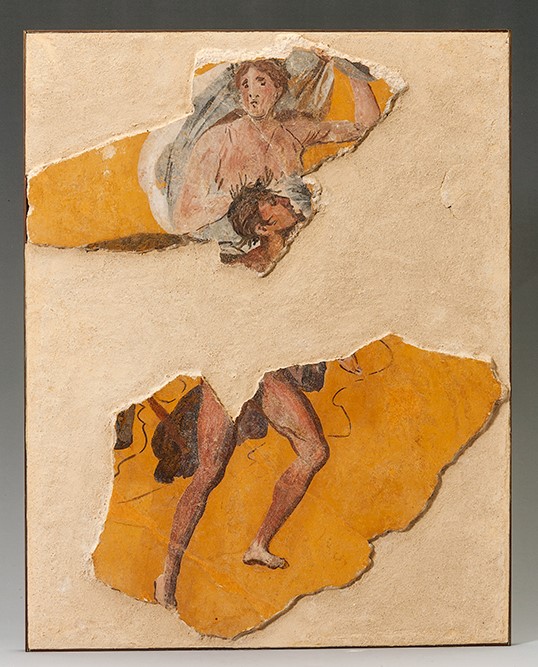Acquisition number: 1978.05
Two fragments from a single scene of which the upper shows the head of a man and the upper part of a woman, the lower the legs of the man and a foot of the woman. The surface is in good condition. Lines of restoration run through the neck and breast of the woman, through the upper part of the male's head and up her right arm; on the lower fragment through the calf of his left leg and across his lower right leg.
The background is a glossy yellow. The flesh of the woman is done in a pale and a stronger pink. The darker shade is also used for her chiton. The hair and the details of her body and the drapery are in brown. Her wreath is dark grey. Her himation is pale blue and white with the folds shown in grey-blue. The male's flesh is red-brown over pink with dark brown for details and shaded areas. His wreath is dark grey; his cloak dark brown to black.
Title: Two Fragments of Roman Wall-Painting - 1978.05
Acquisition number: 1978.05
Author or editor: J.R. Green
Culture or period: Roman Imperial
Date: Mid 1st century AD.
Material: Plaster
Object type: Wall-painting
Dimensions: 250mm (w) × 155mm (h)
Origin region or location: Italy
Display case or on loan: 12
Keywords: Roman, Imperial, Fragment, wall painting, Peleus, Thetis, Satyr, Maenad
Sotheby Parke Bernet (New York), Sale Cat., 10 April 1978, no. 184, pl. XII; J.R. Green with B. Rawson, Catalogue of Antiquities in the Australian National University, A.N.U. (Canberra, 1981) 109.
1978.05
Two Fragments of Roman Wall-Painting
Purchased. The upper fragment ca 15.5 x 25cm; the lower fragment ca 19.5 x 27cm.
Two fragments from a single scene of which the upper shows the head of a man and the upper part of a woman, the lower the legs of the man and a foot of the woman. The surface is in good condition. Lines of restoration run through the neck and breast of the woman, through the upper part of the male's head and up her right arm; on the lower fragment through the calf of his left leg and across his lower right leg.
The background is a glossy yellow. The flesh of the woman is done in a pale and a stronger pink. The darker shade is also used for her chiton. The hair and the details of her body and the drapery are in brown. Her wreath is dark grey. Her himation is pale blue and white with the folds shown in grey-blue. The male's flesh is red-brown over pink with dark brown for details and shaded areas. His wreath is dark grey; his cloak dark brown to black.
The man seems to be carrying off the woman, his cloak billowing out behind him; she wears a chiton and holds up a himation beside and above her head. The subject may be Peleus and Thetis, but compare the satyr and maenad from the House of the Dioscuri at Pompeii, Borda, La pittura romana 62.
Late Third Style; free-floating figures or small groups against plain backgrounds are typical of this style, as is the tendency to elaborate, billowing drapery.
Mid-first century AD.
Sotheby Parke Bernet (New York), Sale Cat., 10 April 1978, no. 184, pl. XII; J.R. Green with B. Rawson, Catalogue of Antiquities in the Australian National University, A.N.U. (Canberra, 1981) 109.

